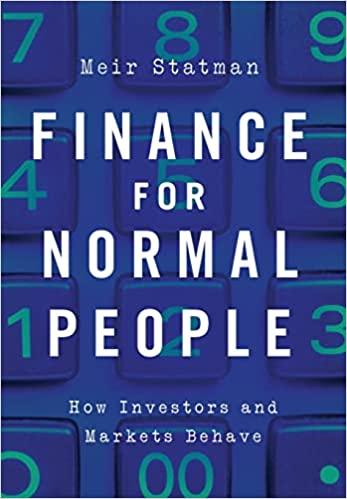Question
Please show me how to calculate (a) to (h) The RTO model for smartphones would work as follwos; Customers could lease a high-end smartphone such
Please show me how to calculate (a) to (h)
The RTO model for smartphones would work as follwos;
Customers could lease a high-end smartphone such as the Apple iPhone with retail price of $649 for a monthly fee of $30 with a minimum term of 12 months. After the minimum term, customers would have three options:
(1) buy the leased phone for $499 or
(2) continue leasing the phone for 30/ moth or
(3) return the leased phone to BB company.
It was estimated that 25% of customers would buy the phone, 25% would return the phone, and the remaining 50% would keep leasing the phone for an average of 24 months, after which they would return the depreciated price. The new phones would cost BB company an average of $599 to acquire. The depreciated value of the phones that BB company could realize was estimated at $499 ate the end of 12 months and $249 at end of 24 months. Due to the risky nature of the customers who would be attracted to the RTO arrangement, it was estimated that 20% of the phones rented under this arrangement would be lost to defaults. In the case of a default, BB company would need to write off the entire cost of buying the phone. Best Buy estimated that 0.5 million customers would sigh up for the RTO model in the first year, 1 million in the second year, and 2 million in the third year. BB company would apply an annual discount rate of 12% to calculate the NPV of the cash flows from the RTO model.
| Rent-to-Own Model | |
| Asssumption | Value |
| Retail price of phone | 649 |
| Cost to acquire fro Best Buy | 599 |
| Monthly lease fee | 30 |
| Repurchase option after 12 months | 499 |
| Depreciated price after 12 months | 449 |
| Depreciated price after 24 months | 249 |
| % Defaults/lost phones | 0.2 |
| % Customers who buy after 12 months | 0.25 |
| % Customer who return after 12 months | 0.25 |
| % Customer who lease for 24 months | 0.5 |
| Expected cash flow | (a) |
| Less cost of defaults | 119.8 |
| Net expected cash flow | (b) |
| Year 1 Customers | 500,000 |
| Year 1 Revenue | (c) |
| Year 2 NPV | (d) |
| Year 2 Customers | 1,000,000 |
| Year 2 Revenue | (e) |
| Year 3 NPV | (f) |
| Year 3 Customers | 2,000,000 |
| Year 3 Revenue | (g) |
| Total Revenue 3 years | (h) |
Step by Step Solution
There are 3 Steps involved in it
Step: 1

Get Instant Access to Expert-Tailored Solutions
See step-by-step solutions with expert insights and AI powered tools for academic success
Step: 2

Step: 3

Ace Your Homework with AI
Get the answers you need in no time with our AI-driven, step-by-step assistance
Get Started


